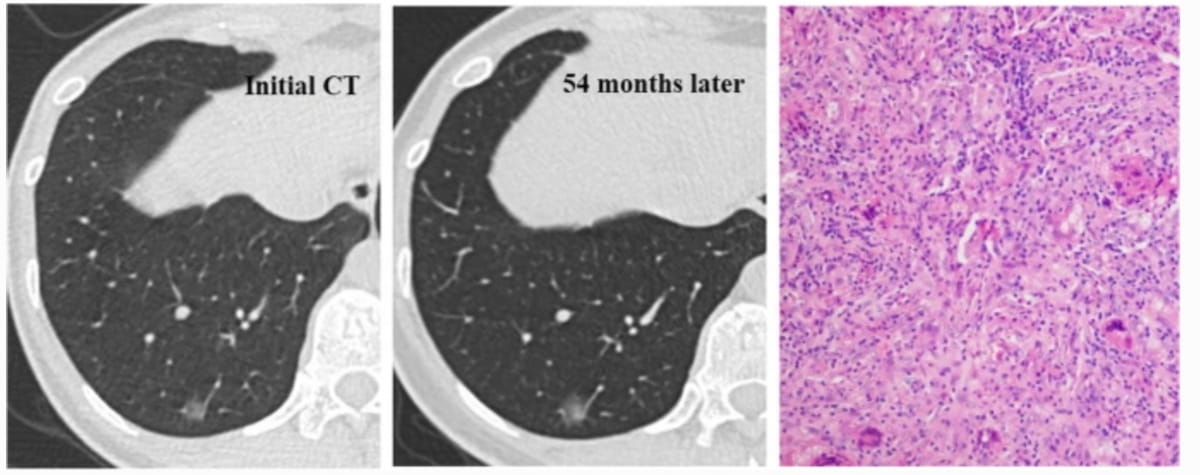Noting a lack of studies on differentiating subsolid nodules (SSNs) with non-contrast computed tomography (CT), researchers recently examined key characteristics of benign and malignant SSNs, correlations with clinical factors and nodule progression.
For the retrospective study, recently published in Insights into Imaging, the authors reviewed follow-up CT exams for 436 patients with SSNs and a solid nodule component of less than or equal to 5 mm. The cohort was comprised of 70 patients with non-absorbable benign SSNs (NB-SSNs), 69 patients with absorbable benign SSNs (AB-SSNs) and 297 with malignant SSNs (M-SSNs), according to the study.
The study authors noted a greater frequency of AB-SSN lesions on follow-up CT exams in comparison to NB-SSN and M-SSN. In contrast to patients with M-SSN, the researchers pointed out that those with AB-SSN were five years younger on average (49 vs. 54 years of age), exhibited respiratory symptoms more frequently (27.54 percent vs. 14.81 percent), and had a greater percentage of satellite lesions (13.04 percent vs. 3.70 percent) and thickened interlobular septa (8.7 percent vs. 1.01 percent).
Patients with M-SSN had significantly higher percentages of bubble lucency (14.81 percent) and pleural retraction (16.16 percent) in comparison to those with NB-SSN (2.86 percent and 10 percent respectively) and patients with AB-SSN (0 percent and 2.9 percent respectively), according to the study authors.
“Familiarity with the clinical and imaging findings of SSNs can help clinicians select optimal therapeutic strategies, minimize overtreatment of benign nodules, and relieve patients’ physical and economic burdens,” wrote study co-author Qi Li, M.D., who is affiliated with the Department of Radiology at the First Affiliated Hospital of Chongqing Medical University in Chongqing, China, and colleagues.
The researchers used three separate models to differentiate between AB-SSN and NB-SSN, between AB-SSN and M-SSN, and between NB-SSN and M-SSN. The study authors found that independent predictive factors of NB-SSNs, in comparison to M-SSNs, included smaller nodule size, irregular shape, target sign, lower ground glass opacity (GGO) CT values and detection during follow-up CT.
In contrast to M-SSNs, the researchers noted that independent predictive non-contrast CT findings for AB-SSNs included ill-defined margins, irregular shape, target sign, absence of bubble lucency, thickened lobular septa, lower GGO CT values and detection during follow-up CT. Ill-defined nodule margins and detection on follow-up CT exams were cited by the study authors as the independent factors differentiating AB-SSNs from NB-SSNs.
“ … Interestingly, we found that newly observed nodules, which were absent on the initial CT and detected during follow-up CT, were most common in AB-SSNs, followed by NB-SSNs, suggesting that SSNs observed during follow-up are strongly indicative of benignity, especially absorbable benignity, whereas M-SSNs tend to persist for longer,” added Li and colleagues.
Three Key Takeaways
- Absorbable benign SSN (AB-SSN) characteristics. AB-SSNs showed a higher frequency on follow-up CT exams compared to non-absorbable benign SSNs (NB-SSNs) and malignant SSNs (M-SSNs). Patients with AB-SSNs were on average five years younger, exhibited respiratory symptoms more frequently, and had a greater percentage of satellite lesions and thickened interlobular septa compared to those with M-SSNs.
- Malignant SSN (M-SSN) characteristics. M-SSNs had significantly higher percentages of bubble lucency and pleural retraction compared to both NB-SSNs and AB-SSNs. Patients with M-SSNs tended to have persisting nodules for longer durations, contrasting with the observed benign behavior in nodules during follow-up, especially in AB-SSNs.
- Predictive factors for nodule differentiation. Independent predictive factors for differentiating NB-SSNs from M-SSNs included smaller nodule size, irregular shape, target sign, lower ground glass opacity (GGO) CT values, and detection during follow-up CT. For differentiating AB-SSNs from M-SSNs, predictive factors included ill-defined margins, irregular shape, target sign, absence of bubble lucency, thickened lobular septa, lower GGO CT values, and detection during follow-up CT. Ill-defined nodule margins and detection on follow-up CT exams were cited as independent factors differentiating AB-SSNs from NB-SSNs.
In external validation testing involving a 151-patient cohort, the researchers found that the model differentiating AB-SSNs from M-SSNs demonstrated the highest AUC (91.2 percent) and accuracy rate (81.8 percent) of the three models. The model for differentiating NB-SSNs from M-SSNs had an AUC of 79.4 percent and an 80.2 percent accuracy rate. Li and colleagues noted that the model for differentiating between AB-SSNs and NB-SNNs had a 79 percent AUC and a 73.9 percent accuracy rate.
(Editor’s note: For related content, see “Study Shows Benefits of AI in Detecting Lung Cancer Risk in Non-Smokers,” “Researchers Cite 81 Percent Survival Rate 20 Years After Initial Lung Cancer Diagnosis with Low-Dose CT” and “CT News: American Cancer Society Issues Updated Lung Cancer Screening Recommendations.”)
In regard to study limitations, the authors acknowledged that the retrospective nature of the study may have resulted in possible selection bias. They also noted a lack of post-contrast data on the assessed nodules in the study and a lack of pathological information for ascertaining the cause of unusual behavior in four benign subsolid nodules.
